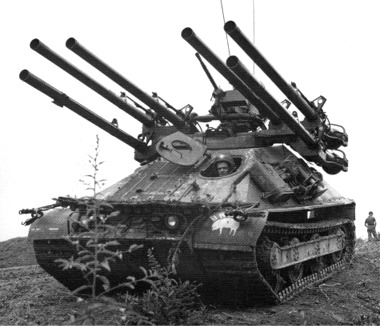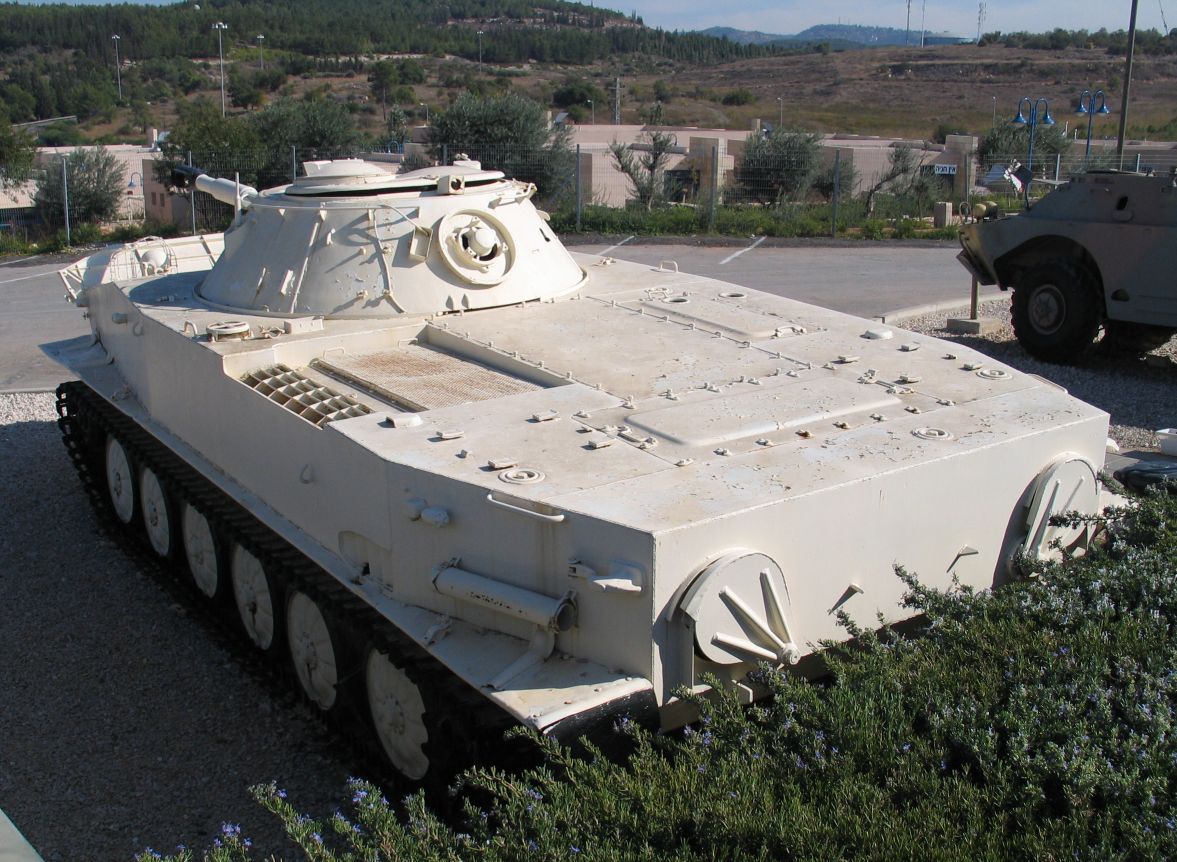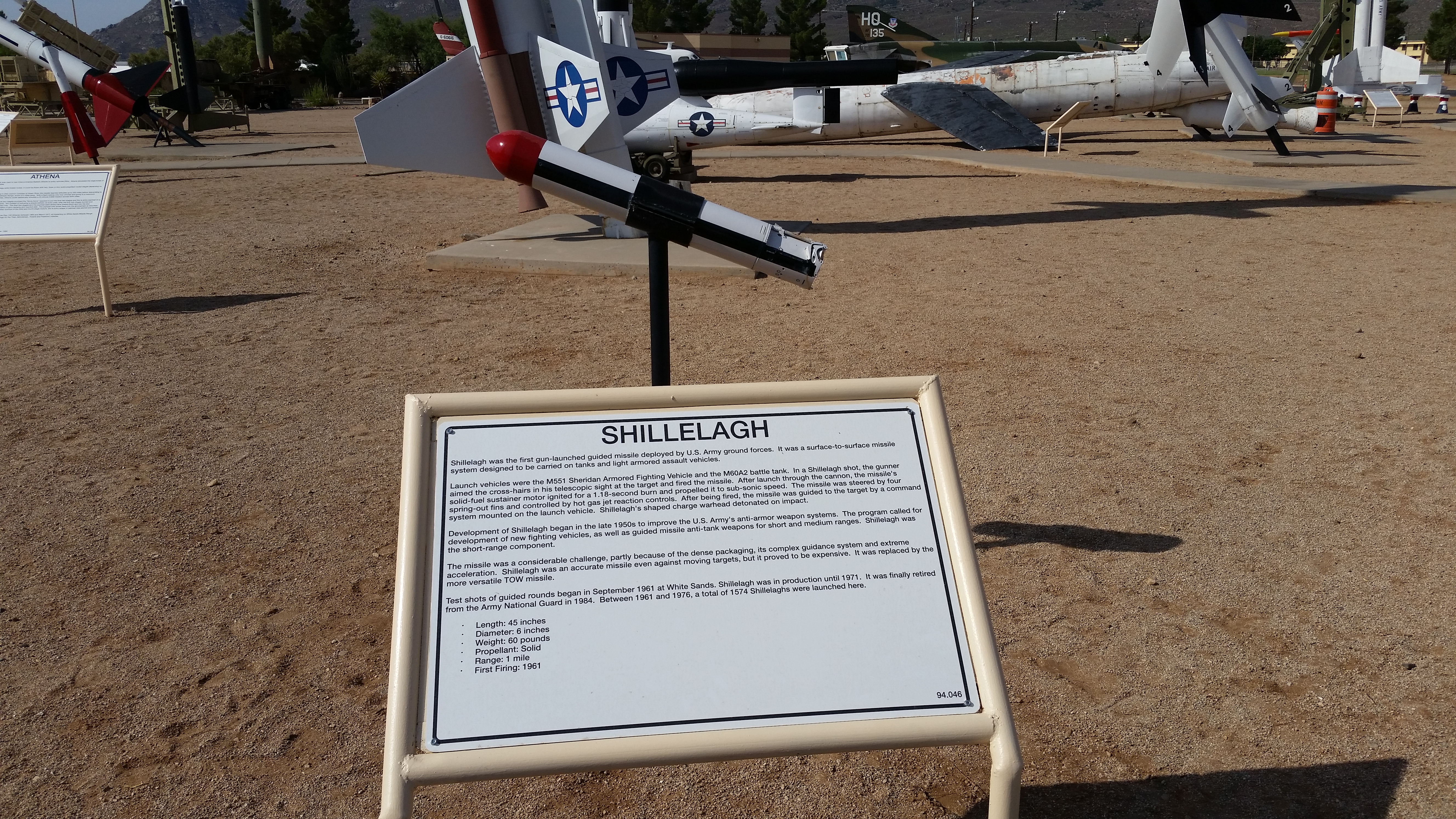|
Tanks Of The U.S. In The Cold War
This article deals with the history and development of American tanks from the end of World War II, and during the Cold War. Light tanks M24 Chaffee Korean War In the Korean War M24 Chaffees were the first U.S. tanks to fight the North Korean T-34, T-34-85s. The M24 fared poorly against these much better-armed and armored medium tanks. When the war began in June 1950, the four American infantry divisions on occupation duty in Japan had no medium tanks at all, having only one active tank company (equipped with M24 Chaffee light tanks) each. When these divisions were sent to Korea at the end of June 1950, they soon found that the 75 mm gun on the M24 could not penetrate the armor of North Korean T-34 tanks, which had no difficulty penetrating the M24's thin armor. M24s were more successful later in the war in their reconnaissance role, supported by heavier tanks such as the Sherman tank, M4, Pershing tank, M26, and M46 Patton, M46. M41 Walker Bulldog The development ... [...More Info...] [...Related Items...] OR: [Wikipedia] [Google] [Baidu] |
Chosin
Chosin may refer to: *USS Chosin (CG-65), USS ''Chosin'' (CG-65), a cruiser of the United States Navy *Battle of Chosin Reservoir, a battle of the 1950–3 Korean War *Changjin_County#History, Lake Changjin also calle Lake Chosin, an artificial lake in Changjin (North Korea), Changjin County, South Hamgyong Province, North Korea {{disambig ... [...More Info...] [...Related Items...] OR: [Wikipedia] [Google] [Baidu] |
Type 61 (tank)
The is a main battle tank developed and used by the Japan Ground Self-Defense Force (JGSDF), built by Mitsubishi Heavy Industries. Development started in 1955 and the vehicle was first deployed in April 1961. The type number follows the year of deployment. A total of 560 Type 61s were manufactured between 1961 and 1975, when production ceased. It was succeeded by the Type 74. History The Empire of Japan had produced a wide range of armoured fighting vehicles. After the Surrender of Japan, however, all AFV development and construction had ceased, and Japan had lost the technology needed to build and manufacture tanks and armored vehicles. However, due to the Korean War, the Supreme Commander of the Allied Powers ordered Japan to re-militarize, forming an armed police force (initially the National Police Reserve, later called the National Security Force, and finally renamed the Japan Ground Self Defense Force) and provided M4A3E8 Sherman medium tanks and M24 Chaffee light tank ... [...More Info...] [...Related Items...] OR: [Wikipedia] [Google] [Baidu] |
M551 Sheridan
The M551 "Sheridan" AR/AAV ( Armored Reconnaissance/Airborne Assault Vehicle) was a light tank developed by the United States and named after General Philip Sheridan, of American Civil War fame. It was designed to be landed by parachute and to swim across rivers. It was armed with the technically advanced but troublesome M81/M81 Modified/M81E1 152 mm gun/launcher, which fired both conventional ammunition and the MGM-51 Shillelagh guided anti-tank missile. The M551 Sheridan entered service with the United States Army in 1967. At the urging of General Creighton Abrams, the U.S. Commander, Military Assistance Command Vietnam, at the time, the M551 was rushed into combat service to South Vietnam in January 1969. Later that year, M551s were deployed to units in Europe and South Korea. The Sheridan saw extensive combat in the Vietnam War, where problems with the platform became evident, particularly its poor survivability and reliability. Based on its experiences in Vietnam, the A ... [...More Info...] [...Related Items...] OR: [Wikipedia] [Google] [Baidu] |
Shillelagh Missile
The Ford MGM-51 ''Shillelagh'' (MGM meaning Mobile Guided Missile) was an American anti-tank guided missile designed to be launched from a conventional gun (cannon). It was originally intended to be the medium-range portion of a short, medium, and long-range system for armored fighting vehicles in the 1960s and '70s to defeat future armor without an excessively large gun. Developing a system that could fire both shells and missiles reliably proved complex and largely unworkable. It was originally developed for the experimental but never produced MBT-70 tank and served most notably as a primary weapon of the M551 Sheridan light tank, but the missile system was not issued to units serving in South Vietnam and was retired in 1996. It was also used on the M60A2 "Starship", which was phased out by 1981. Ultimately, very few of the 88,000 rounds produced were ever fired in combat, and the system was largely succeeded by the later BGM-71 TOW wire-guided missile, which was first produced ... [...More Info...] [...Related Items...] OR: [Wikipedia] [Google] [Baidu] |
Ontos Tank
Ontos, officially the Rifle, Multiple 106 mm, Self-propelled, M50, was a U.S. light armored tracked anti-tank vehicle developed in the 1950s. It mounted six 106 mm manually loaded M40 recoilless rifles as its main armament, which could be fired in rapid succession against single targets to increase the probability of a kill. Although the actual caliber of the main guns was 105 mm, it was designated 106 mm to prevent confusion with the ammunition for the 105 mm M27 recoilless rifle, which the M40 replaced. It was produced in limited numbers for the U.S. Marines after the U.S. Army cancelled the project. The Marines consistently reported excellent results when they used the Ontos for direct fire support against infantry in numerous battles and operations during the Vietnam War. The American stock of Ontos was largely expended towards the end of the conflict and the Ontos was removed from service in 1969. Development The ''Ontos'' (Greek for "thing") proje ... [...More Info...] [...Related Items...] OR: [Wikipedia] [Google] [Baidu] |
Recoilless Rifle
A recoilless rifle, recoilless launcher or recoilless gun, sometimes abbreviated "RR" or "RCL" (for ReCoilLess) is a type of lightweight artillery system or man-portable launcher that is designed to eject some form of countermass such as propellant gas from the rear of the weapon at the moment of firing, creating forward thrust that counteracts most of the weapon's recoil. This allows for the elimination of much of the heavy and bulky recoil-counteracting equipment of a conventional cannon as well as a thinner-walled barrel, and thus the launch of a relatively large projectile from a platform that would not be capable of handling the weight or recoil of a conventional gun of the same size. Technically, only devices that use spin-stabilized projectiles fired from a rifled barrel are recoilless rifles, while smoothbore variants (which can be fin-stabilized or unstabilized) are recoilless guns. This distinction is often lost, and both are often called recoilless rifles. Though sim ... [...More Info...] [...Related Items...] OR: [Wikipedia] [Google] [Baidu] |
Anti-tank Missile
An anti-tank guided missile (ATGM), anti-tank missile, anti-tank guided weapon (ATGW) or anti-armor guided weapon is a Missile guidance, guided missile primarily designed to hit and destroy Armoured fighting vehicle, heavily armored military vehicles. ATGMs range in size from shoulder-launched weapons, which can be transported by a single soldier, to larger tripod-mounted weapons, which require a squad or team to transport and fire, to vehicle and aircraft mounted missile systems. Earlier man-portable anti-tank weapons like anti-tank rifles and magnetic anti-tank mines, generally had very short range, sometimes on the order of metres or tens of metres. Rocket-propelled high-explosive anti-tank (HEAT) systems appeared in World War II and extended range to the order of hundreds of metres, but accuracy was low and hitting targets at these ranges was largely a matter of luck. It was the combination of rocket propulsion and remote wire guidance that made the ATGM much more effective ... [...More Info...] [...Related Items...] OR: [Wikipedia] [Google] [Baidu] |
Muzzle Velocity
Muzzle velocity is the speed of a projectile (bullet, pellet, slug, ball/shots or shell) with respect to the muzzle at the moment it leaves the end of a gun's barrel (i.e. the muzzle). Firearm muzzle velocities range from approximately to in black powder muskets, to more than in modern rifles with high-velocity cartridges such as the .220 Swift and .204 Ruger, all the way to for tank guns firing kinetic energy penetrator ammunition. To simulate orbital debris impacts on spacecraft, NASA launches projectiles through light-gas guns at speeds up to . Projectile velocity For projectiles in unpowered flight, its velocity is highest at leaving the muzzle and drops off steadily because of air resistance. Projectiles traveling less than the speed of sound (about in dry air at sea level) are ''subsonic'', while those traveling faster are ''supersonic'' and thus can travel a substantial distance and even hit a target before a nearby observer hears the "bang" of the shot. Projec ... [...More Info...] [...Related Items...] OR: [Wikipedia] [Google] [Baidu] |
HEAT
In thermodynamics, heat is defined as the form of energy crossing the boundary of a thermodynamic system by virtue of a temperature difference across the boundary. A thermodynamic system does not ''contain'' heat. Nevertheless, the term is also often used to refer to the thermal energy contained in a system as a component of its internal energy and that is reflected in the temperature of the system. For both uses of the term, heat is a form of energy. An example of formal vs. informal usage may be obtained from the right-hand photo, in which the metal bar is "conducting heat" from its hot end to its cold end, but if the metal bar is considered a thermodynamic system, then the energy flowing within the metal bar is called internal energy, not heat. The hot metal bar is also transferring heat to its surroundings, a correct statement for both the strict and loose meanings of ''heat''. Another example of informal usage is the term '' heat content'', used despite the fact that p ... [...More Info...] [...Related Items...] OR: [Wikipedia] [Google] [Baidu] |
PT-76
The PT-76 is a Soviet amphibious light tank that was introduced in the early 1950s and soon became the standard reconnaissance tank of the Soviet Army and the other Warsaw Pact armed forces. It was widely exported to other friendly states, like India, Iraq, Syria, North Korea and North Vietnam. The tank's full name is Floating Tank–76 (, ''plavayushchiy tank'', or ). ''76'' stands for the caliber of the main armament: the 76.2 mm D-56T series rifled tank gun. The PT-76 is used in the reconnaissance and fire-support roles. Its chassis served as the basis for a number of other vehicle designs, many of them amphibious, including the BTR-50 armored personnel carrier, the ZSU-23-4 self-propelled antiaircraft gun, the ASU-85 airborne self-propelled gun and the 2K12 Kub anti-aircraft missile launch vehicle. Development After World War II, the concept of light tanks was resurrected in the USSR. They were to be used in reconnaissance units and therefore an amphibious ability wa ... [...More Info...] [...Related Items...] OR: [Wikipedia] [Google] [Baidu] |
MGM-51 Shillelagh2
The Ford MGM-51 ''Shillelagh'' (MGM meaning Mobile Guided Missile) was an American anti-tank guided missile designed to be launched from a conventional gun (cannon). It was originally intended to be the medium-range portion of a short, medium, and long-range system for armored fighting vehicles in the 1960s and '70s to defeat future armor without an excessively large gun. Developing a system that could fire both shells and missiles reliably proved complex and largely unworkable. It was originally developed for the experimental but never produced MBT-70 tank and served most notably as a primary weapon of the M551 Sheridan light tank, but the missile system was not issued to units serving in South Vietnam and was retired in 1996. It was also used on the M60A2 "Starship", which was phased out by 1981. Ultimately, very few of the 88,000 rounds produced were ever fired in combat, and the system was largely succeeded by the later BGM-71 TOW wire-guided missile, which was first produced ... [...More Info...] [...Related Items...] OR: [Wikipedia] [Google] [Baidu] |









